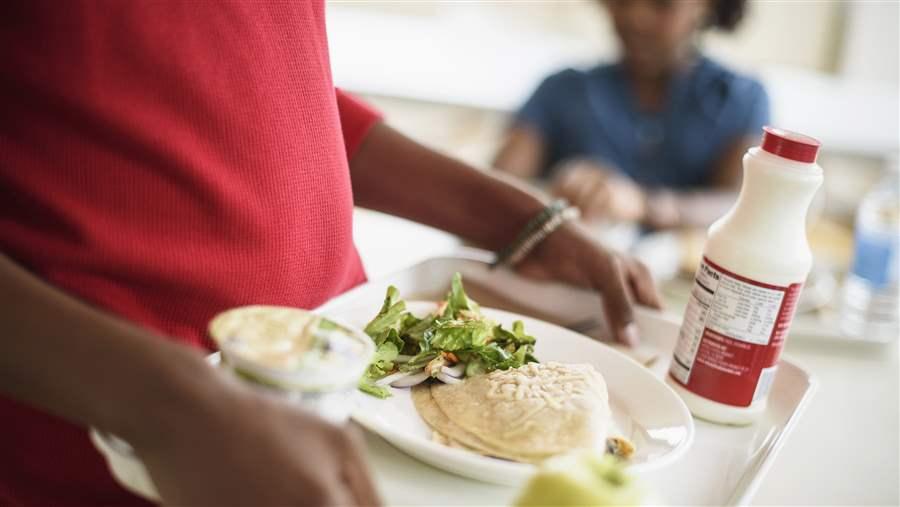How Can Students Access Free Meals on Campus
In the bustling life of a student, every dollar saved matters. College campuses are buzzing with activities and studies, but amidst all this energy lies a concern that often goes unnoticed – hunger.
Many students struggle to access nutritious meals due to tight budgets and rising expenses. It’s not just about filling the stomach; it’s about fueling minds for academic success.
Here’s an eye-opener: research reveals over 650 colleges have set up food pantries for students in need as of September 2018, reflecting a growing effort to tackle student hunger.
Our blog guides you through various ways to access free meals on campus – from utilizing national programs to engaging with local community initiatives. We’ll share tips that address immediate needs and promote overall well-being by ensuring no student has to study on an empty stomach.
Ready for some practical advice? Let’s dive into some sustenance strategies!
Key Takeaways
- Students can get free or low-cost breakfast and lunch at school through the National School Breakfast and Lunch Program.
- There are summer meal programs that give kids under 18 years old free food in the summer.
- Use tools like the Free Meals Finder to find places on campus to get free meals.
- Checking with your school\’s food program can help you learn more ways to access nutritious meals.
- Community organizations sometimes team up with schools to give out free meals, especially during summer when there’s no school lunch.
Free Meal Programs for Students

Students can access free meal programs through various government-sponsored initiatives, such as the National School Breakfast and Lunch Program, Summer Meal Programs, Kids Cafe, Ohio Summer Food Service Program, and Free Summer Meals for Kids.
These programs aim to combat food insecurity among students and ensure they have access to nutritious meals during the school year and over the summer months.
National School Breakfast and Lunch Program
The National School Breakfast and Lunch Program helps kids get free or cheap meals at school. If your family doesn’t make much money, you might not have to pay for breakfast or lunch.
This is a big way to save money during the school year. Many children can eat healthy foods because of this program. Good food helps them do well in class.
You can see if you qualify for these meal programs by filling out an application at your child’s school. Schools will examine how much your family makes to see if you can get free or lower-priced meals.
Getting this help means one less thing to worry about, and it lets you keep more cash for other needs.
Summer Meal Programs
Free food doesn’t have to stop moving from the school year into summer. Summer Meal Programs feed kids and teens up to 18 at no cost. These aren’t just for lunch; they often involve fun activities that mix learning and play.
If you want to save money, these programs are a big help. Schools in areas where many families don’t earn much money can give out meals and snacks for free because the U.S. Department of Agriculture helps them pay for it.
Want to find where these foods are served? Look on the USDA Summer Meals Site Finder online or ask your local school when schools close down for summer break.
Kids Cafe
Just like summer meal programs, Kids Cafe steps in to help students who need food. It’s a special place where kids can get free meals after school, during holidays, and in hot summers.
At these cafes, children eat for no cost and have fun doing activities with friends.
Kids Cafe is perfect if you’re looking to save money on meals. This program understands that young ones should stay full and ready for life’s adventures. You can find one of these cafes in many areas; they give out healthy food so kids can grow strong without costing a dime.
And the best part? While kids enjoy their meals, they laugh and play—turning mealtime into a great part of their day!
Ohio Summer Food Service Program
The Ohio Summer Food Service Program offers free summer meals for kids aged 1 to 18 at certain locations. Children with disabilities up to age 21 can also get these meals at no cost.
These sites are often found in low-income communities and rural areas, providing food and activities. This program is set to begin on May 31st, with nutritious meals served every day through the summer.
This program aims to ensure that children who depend on free or reduced-price meals during the school year still have access to healthy meals when school is out. Additionally, sponsoring agencies receive reimbursement through this program for offering these nutritious snacks and meals in eligible sites.
Free Summer Meals for Kids
Through the Summer Food Service Program, families can find approved meal sites in their communities where kids under 18 can access free meals during the summer. These nutritious meals made possible through USDA’s summer meal programs, provide a cost-free way for parents to ensure their children have access to healthy food during the summer months when school meal programs are unavailable.
This valuable resource helps families save money while ensuring that children receive essential nutrition, addressing food insecurity among youth.
The program offers nutritious meals to children up to age 18 at no cost. Families can find approved meal sites in their communities where kids can access free meals during the summer.
Finding Free Meals on Campus

To find free meals on campus, students can use the Free Meals Finder tool, check with their school’s food program, and look for community organizations offering free meals. These resources can help alleviate the financial burden and ensure access to nutritious meals for college students.
Use the Free Meals Finder tool
Accessing free meals on campus is easier with the Free Meals Finder tool, a valuable resource helping students locate nutritious and cost-free meal options through community organizations.
By entering your location, this user-friendly tool provides comprehensive information about local programs offering free meals to those in need, ensuring you can find support without any added financial burden.
With just a few clicks, students can discover nearby opportunities to access healthy meals for free, making it a convenient way to alleviate food expenses while pursuing their education.
Check with your school’s food program
After utilizing the Free Meals Finder tool, exploring additional options, such as checking with your school’s food program, is essential. Many educational institutions offer various meal assistance programs that can help alleviate financial burdens and ensure access to nutritious meals for students.
By connecting with your school’s food program, you can inquire about eligibility criteria, application processes, and available resources tailored to meet the specific needs of students.
This proactive approach can provide valuable support in addressing food insecurity among college students while promoting overall well-being and academic success.
It is important to note that schoolwide free-meal programs have effectively increased the number of meals served, demonstrating the positive impact of such initiatives on student nutrition.
Look for community organizations offering free meals
Many community organizations partner with schools to provide free meals for needy students, particularly those in low-income areas. These partnerships aim to combat food insecurity among students and alleviate the financial burden on families.
Community organizations often receive support from federally funded programs such as the USDA’s Summer Food Service Program, which allows them to offer free meals and snacks to students during the summer break when access to school meals may be limited.
Students can save money by connecting with these organizations and accessing nutritious meals without worrying about additional expenses.
Benefits of Free Meals for Students

Access to free meals on campus can have a significant positive impact on students. It helps improve food insecurity, encourages healthy eating habits, and reduces the financial burden on students.
Improving food insecurity
Access to free or reduced-price school meals can help improve food insecurity among students. When students have access to nutritious meals, it reduces the worry of not having enough food, which is crucial for their overall well-being.
Studies show that providing free meals at schools positively reduces food insecurity and improves health outcomes.
Furthermore, access to free school meals also leads to better student attendance and academic performance. This means that not only does it address immediate hunger needs, but it also contributes to the long-term success of students in their education.
By addressing food insecurity through meal programs, students can focus better on their studies without worrying about where their next meal will come from.
Encouraging healthy eating habits
Students can build healthy eating habits by addressing food insecurity without draining their finances. Access to free meals on campus ensures that students have the opportunity to make nutritious meal choices, supporting not only physical health but also mental well-being.
Recognizing the impact of healthy dining options in enhancing academic performance, it becomes essential for students to derive sustenance from balanced and nourishing meals. This positive cycle of access to free meals and promoting nutritional wellness ultimately contributes to a more conducive learning environment where financial concerns do not impede the cultivation of healthy habits.
Reducing the financial burden on students
One of the significant advantages of free meal programs for students is reducing their financial burden. Students often face challenges in managing their expenses, and providing access to free meals can help alleviate some of these financial pressures.
By eliminating the cost of meals, students can redirect their limited funds toward other essential needs, such as educational resources and living expenses. This support promotes their well-being and contributes to a more inclusive and equitable campus environment, ensuring that all students have access to nutritious food regardless of their financial circumstances.
Implementing schoolwide free-meal programs can lead to potential changes in meal costs and dietary quality, positively impacting students’ overall well-being while reducing disparities in access to essential nutrition.
Conclusion
Students can access free meals on campus through various programs. Finding these meals is possible using tools like the Free Meals Finder, checking with the school’s food program, or seeking community organizations offering free meals.
These initiatives help address food insecurity and promote healthy eating habits while alleviating financial burdens for students. By recognizing the importance of free meals in enhancing students’ well-being, educational institutions and communities can work together to ensure all students have access to nutritious meals on campus.
FAQs

1. How can college students get free meals on campus?
Many college students can eat for free or at a reduced price through programs like the Supplemental Nutrition Assistance Program (SNAP) by filling out a meal application and getting it approved.
2. What is SNAP, and how does it help students with food?
SNAP is a food assistance program run by the Food and Nutrition Service agency that helps low-income households, including some college students, buy healthy food.
3. Can all students use SNAP to get food on campus?
Not all students can use SNAP; there are rules about who qualifies. But if you’re going to community college or another higher education place, check with student services to see if you can get SNAP.
4. Are there other ways for students to find free food besides SNAP?
Yes! Some schools have pantries where students can pick up groceries, and they often send out newsletters about openings of new places where you can dine without cost.
5. Do colleges offer help so I don’t waste time figuring out how to apply for these programs?
Yes, most student services offices have people who will assist state and local officials in helping make sure you’re using the best practices when applying for nutritional programs.
6. Is my personal information safe when I apply for food help at school?
When using https:// sites connected with the federal government, like those offering info about national nutrition programs, your email address and other sensitive information should stay protected.

